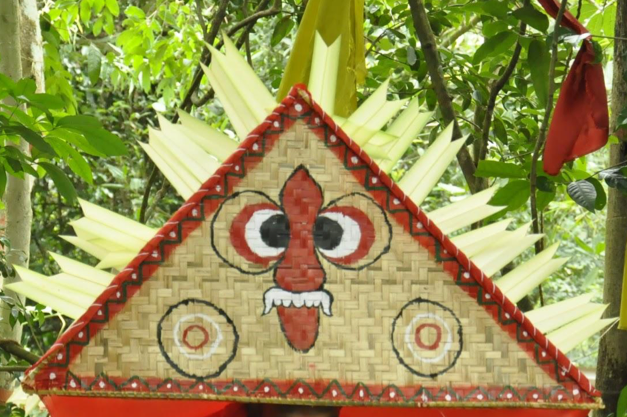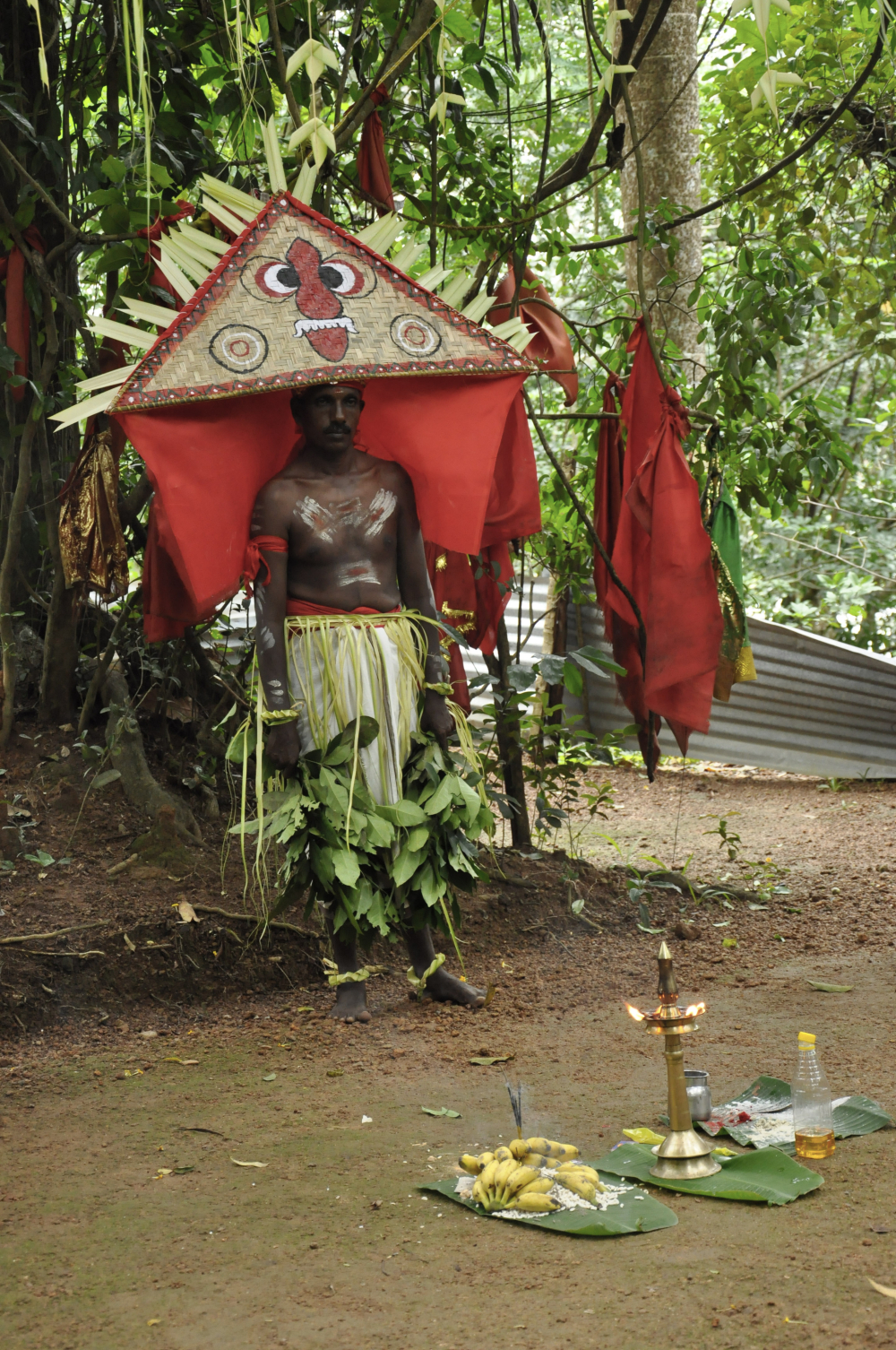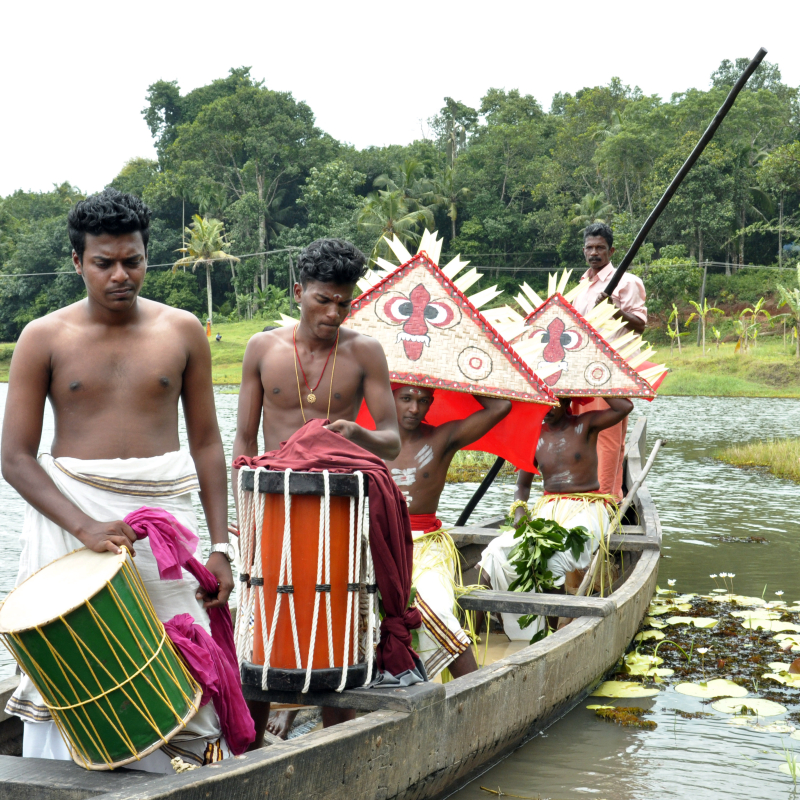Introduction
Art forms that are a part of a community’s oral traditions are performed and practised as a way of life and represent the soul of village life. They often manifest as communal-singing and dancing during festivals and special occasions—primarily done to please local deities. There is little to differentiate the performers from their audience in such art forms. The performers and the audience sing and dance together blurring the boundary between performance and reception. For the people of the community, being a participant in the performance is akin to floating through history and time, experiencing the collective memories of their community. People participate in the performance by singing, dancing and cheering the performers. This helps to deepen the bonds between the people of the community.
These songs and performances are unique in that they develop over generations, with no particular creator being credited for them. New elements and lyrics are added in the course of time, through a system of collective authorship within the community. Unlike contemporary art forms in which individual authors are ascribed significance, the authorship and ownership of such art forms are attributed to the community which practises them. Pakkanar Kali is a part of such a collective art tradition.
In folklore studies, the songs and dance forms of Kerala have been classified according to region, as thekkanpattukal (southern ballads) and vadakkanpattukal (northern ballads). But in this classification, the idanadan (places between the north and south) art forms have been left uncategorised. Several of these, such as Chenganooradhi, Padayani, Pakkanar Kali and Bharatha Kali were later recognised by researchers.[1]
Pakkanar Kali is considered the dance form of the Paraya community. No other community performs it. A likely reason is that the art form is deeply embedded in the mythos of the Pakkanar and the Paraya community. The question of whether Pakkanar actually lived is not important, as what is of more relevance is that there exists a community which believes that they are his descendants. Traces of this claim are evident in Pakkanar Pattukal (the songs that tell the story of Pakkanar), all of which are quite rich in philosophical verse. One of the songs that begins with the lines ‘ariyariyo thiririyo’ goes:
Cholluvanere kadhakalundu,
Akkadha kelkkan ningal venam,
Akkadha kettangu poyidenam.
([Pakkanar] Has several stories to tell
You must be present to listen to them
You must go only after listening to them)
According to the story of Parayi Petta Panthirukum in Aithihyamala (Garland of Legends),[2] Pakkanar was one of 12 children born to Vararuchi, a Brahmin man, and Panchami, a Paraya woman. The story goes that the 12 children later became the founders of 12 different castes and lived in harmony by performing different community jobs.
Pakkanar Kali begins from the atham day of the Malayalam calendar month of Chingam, the day on which preparations for Onam begin. I still have fond memories of travelling with a Pakkanar Kali group as a child. We crossed paddy fields, village roads, narrow paths and hills with a lighted choottu (flambeau). We performed Pakkanar Kali in front of each home where people were waiting for us—they indicated this by lighting a lamp. We sang songs such as pinipattu (songs sung to cure diseases) and kolampattu (songs sung for Kolam Kali, played wearing kolam or headgear), praying to various deities to shield the village from misery and bad luck. The villagers reacted with respect. They welcomed us and gave us gifts such as money and food grains. At each house, members of the resident family participated in the performance.
When a Pakkanar Kali group returns to their kavu (place of worship of the local deities), they are greeted by the warm voices and cheers of waiting family members. The performers then remove their kolam and lay down their musical instruments. They proceed to measure the quantity of food grains and money that they had managed to collect as gifts. A portion of this is offered to the deities and the rest is distributed among the performers. This is repeated until the fifth day of Onam (according to the Malayalam calendar, the first day of Onam falls on the uthradam day and the fifth falls on purooruttathi).
Ritualistic Preparations for the Performance
The women of the Paraya families would split the rattan that they had collected from the forests and weave them into the Pakkanarkolam—a headgear, usually triangular in shape. The big kolam is for Pakkanar and the small one is for Devanar (a man who accompanies Pakkanar). Eyes and other symbols that are a part of Bhadrakali (Goddess Kali) worship are drawn on the kolams in black, white and yellow. Arrows made of tender coconut palm leaves are placed on the sides of the kolam. A small basket is fitted on the back of the kolam so that it stays on the head. (Fig. 1)

Fig. 1. Pakkanarkolam, a triangular headgear made using split rattan (Courtesy: Mahesh Thenaadi)
Different images are drawn on the faces of the performers using black, red and white paint. Basma (calx) is also applied on the forehead. The performers wear wristbands and ankle straps made of kuruthola (tender coconut palm leaves). Split kuruthola are wrapped around the waist like a skirt, and a necklace made of pala (areca nut and palm spathes) is worn around the neck. (Fig. 2) The singers also have kaimanis (small cymbals) to play along with the musicians. Usually, there are 10 members in each group, and a group with a choottu escorts the performers to the different villages. Thappu (a south Indian drum with circular frame and its one side covered with cowhide, played using two sticks during festivals and funerals), chenda (a high-toned drum from Kerala, played with two sticks), para (a small drum played on both sides with two sticks), thudi (a melodic drum played with a hand or a stick; its skin can be tightened and loosened to change the tone for melodic effect) and kaimani (a small cymbal) are the instruments used for the performances.

Fig. 2. A Pakkanar Kali performer in his attire (Courtesy: Mahesh Thenaadi)
The Performance
As soon as the atham day ends, Pakkanar Kali begins. Before the performances, the Pakkanar performers offer a prayer to the deities. Several banana leaves are placed before the idols and a five-wick lamp is lit. A filled nazhi (a measure), para (used to measure quantity of food grains), ritual offerings for Ganapathi (Hindu God) and betel leaves are placed before the idol. The performers extend their prayers in each of the cardinal directions. The kolams and instruments are given to the performers after they complete their puja. They are then granted permission by Pakkanar to play the instruments. And then, the singers start singing.
The performance starts with a rendition of a vaithari (verses which do not have specific meaning, but are sung in the same melodic pattern as the song which is to be sung). Upon completing it, the song follows):
Ariariyothirithiriyothirithiriyothirithelikku
Palaringamvadakkudeshatthuninnumavelivaravathunde
Mavelivaravathundekoodepakkanarumvaravathunde(. . . Light the lamp
Maveli is arriving from Palaringam land in the north [an unknown place which only finds mention in Pakkanar songs]
Maveli is arriving, and Pakkanar is accompanying him.)
The song explains how the path should be prepared for Maveli (the legendary king, considered the most righteous king who ruled the part of the world now known as Kerala; Onam is believed to be the celebration of Maveli’s visit to Kerala to meet his subjects) and Pakkanar.
Chathuramottha thirumuttatthu
Chandravritthi kalamezhuthi
Akkalatthil jalam kudanju
Thooshanila vachidenam
Anjuthiri nilavilakku vakka venam
Ponnu malokare
Niranaazhiyum niraparayum
Ganapathikku vekka vanam
Muppatthu mukkodi devakalum
Ikkalatthil vasikka venam
Ikkalatthil pooja kollaan
Arupatthiyaaru kodi asurakalum
Ikkalatthil vasikkvenam
Ikkalatthil pooja kollaan
Mupatthi mokkodi devakalum
Pandorumichu kidanna kalam
Irulumillaathe veluvumillathe angane
Ottuyugam kazhinju
Chandarnilla sooryanillathe angane ottu yugam kazhinju
The paths, narrow lanes, wells, ponds and homes should all be thoroughly cleaned. Old clothes and other waste should be thrown away. Banana leaves are placed in the centre of a circle in front of a house and some water is sprinkled over them. A lamp with five wicks (anjuthirinilavilakku) should also be lit. Furthermore, in preparation for the arrival of Ganapathi, a filled nazhi and para should be kept.
Myths Surrounding Pakkanar Kali
According to legend, 33 million gods reside in the circle drawn to mark the place for puja. Additionally, the circle also contains 66 million asuras, meaning that prayers must be offered to them as well. Once upon a time, these 33 million gods lived together. Back then, there was no darkness and light and the moon did not exist. Pakkanar’s song explains how the Earth was formed and how human beings and other living beings came to live on Earth.
In those days, there were two Brahmin families—Thekkanilam and Vadakkanilam (Southern illam and Northern illam; illam is a traditional Brahmin home). In those ancient times, they had no equipment to clean houses and furnish rooms. Animal excrement was used to plaster the floor. However, this was not very comfortable to sit on. The families heard that Goddess Mahalakshmi (considered the Goddess of wealth and prosperity) possessed four varieties of cows. The elder mother of the two families went to Mahalakshmi and begged her to gift them a cow. Hearing her pleas, Mahalakshmi requested the cows to go to Earth. However, the cows were unwilling to go. They said that human beings are cruel and would treat them badly—they would beat them up. Later, however, Mahalakshmi succeeded in convincing a cow named Painkurali to go to Earth. The sisters of the two families took care of the cow’s needs. Then, Painkurali became pregnant. She gave birth to a bull. As a result, Painkurali began to lactate and give five nazhi of milk in the mornings and six nazhi of milk in the evenings. The milk received in the mornings was kept aside for the younger sister and her children, while the milk received in the evening was for the elder sister and her children.
A while later, the sisters began to quarrel with each other over the milk. By this time, Painkurali had grown old, and soon, she died. Her body was cremated, and while it was burning, the fat from her body fell on the both sisters. The elder of the two happened to lick it off her fingers. For this, she was ostracised from her family. Despairing in spite of herself, the elder one prayed to Lord Shiva, and Shiva appeared before her. According to the song, Lord Shiva instructed her to live in a hut in Pazhoor and to make a living by crafting baskets and mats with bamboo and rattan. Parayas are believed to be the descendants of the elder sister. The myth says that this is how the Parayas started residing in the hills and near paddy fields, making their livelihoods by crafting and selling bamboo products.
There is a song that narrates how Pakkanar made 101 murrams (winnow) and went to households and sat and sang in front of them in order to sell the murrams. He would say, “take the murram, keep some salt, turmeric, and grains for me in the corner, and I will take them and leave”. He would give the household a muram for free. As such, Pakkanar would rid each home of any potential harm or ill luck. Pakkanar could do this because he practised manthravadam (sorcery), which he would use to get rid of evil spirits that often possess a person’s body. It is also believed that Pakkanar protects people from ill fate.
In fact, Pakkanar cured Vishnu’s illness. Pakkanar successfully did this using manthravadam, songs and dance. The following song, piniyozhika was sung in order to get rid of evil spirits. This is also sung along with Pakkanar Pattu during Pakkanar Kali.
Piniyozhikapiniyozhikaikkolathiltheernnozhika
Thulliyaditheernnozhika
Aadiyaadipiniyozhika
Piniyozhikapiniyozhika
Pakkanarkolathilpiniyozhika.(Let the disease be cured, completely
While we jump
While we dance
Let the disease be cured
With the Pakkanar kolam)
After singing the pinipattu (the song to cure diseases and ward off evil spirits), the Pakkanar Kali group moves on to the kolam song:
Aaruthannekolamthanne
Thiruvaranmulavazhumbhagavanthanne
Kannukaruthorukarimpadakozhiye
Kuttamurammuramthinnavalevaa.(Who gave you the kolam?
The God of Thiruvaranmula gave it
Come, Oh Goddess who ate the black-legged rooster)
A part of the song is sung in order to get rid of small pox and conjunctivitis. The Pakkanar Pattu is sung and danced in the traditional style. No significant changes have been made to the form over the years. Some experiments were done by Adichan Alakkode in Pattazhi, during my father’s younger days. Much of the community still holds the art form close to their hearts despite the many changes that community life has undergone over the years.
Notes
[1] Appukuttan, Arivu, Thiruvu, Thiricharivu.
[2] Shankunni, ‘Parayi Petta Panthirukulam.’
Bibliography
Appukuttan, A.K. Arivu, Thiruvu, Thiricharivu: Parayarude Pattukal. Thiruvananthapuram: Kerala Bhasha Institute, n.d.
Kuttappan, A.K. Parayarude Pattukal. Thiruvananthapuram: Kerala Bhasha Institute, 2015.
Mohan, Manila C. ‘Ente Paraya Jeevitham.’ Mathrubhumi Weekly, June 28, 2015.
Payyanad, Raghavan. Folklore. Thiruvananthapuram: Kerala Bhasha Institute, 1986.
Rajagopal, C.R., ed. Nattarivu Pattukal. Kottayam: Kottayam: DC Books, 2008.
Shankunni, Kottarathil. ‘Parayi Petta Panthirukulam’, in Aithihyamala. Kottayam: DC Books, 2017.













